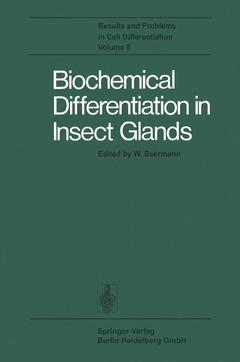Description
Biochemical Differentiation in Insect Glands, Softcover reprint of the original 1st ed. 1977
Results and Problems in Cell Differentiation Series, Vol. 8
Coordinator: Beermann W.
Language: English
Subject for Biochemical Differentiation in Insect Glands:
Publication date: 11-2013
215 p. · 17x24.4 cm · Paperback
215 p. · 17x24.4 cm · Paperback
Description
/li>Contents
/li>
The majority of studies devoted to animal development traditionally start out from questions of morphogenesis. Of course, visible differentiation, as well as the events leading to it, should ultimately become describable in molecular terms. Nevertheless, even "simple" morphogenetic processes may have a complex biochemical basis which makes it difficult to recognize the key functions involved. This difficulty obviously does not exist in the case of glands, i. e. , organs and tissues primarily concerned with, and characterized by, the nature of their products, i. e. , one, or a few secretory proteins synthesized in huge quantities. In these systems, when we observe differences between different portions of a gland, or when switches of the synthetic activity occur during development, there is no question as to what we have to look for: we are directly faced with the fact of differential protein synthesis and the problem of its control. Insect glands, in addition, share other significant properties, i. e. , the absence of cell division during growth and, concomitantly, the formation of giant cells with polyploid or polytene nuclei. This unique set of peculiarities can be fully exploited only if one compares various representative systems, everyone of which, when considered by itself, might appear too exotic to invite generalization. In the present volume, the editors have endeavored to bring together contributionscoveringselected insect glands from various points of view,including the developmental, molecular genetic and cytogenetic aspects.
Differentiation of the Silk Gland. A Model System for the Study of Differential Gene Action.- The Eggshell of Insects: Differentiation-Specific Proteins and the Control of Their Synthesis and Accumulation During Development.- The Salivary Gland of Chironomus (Diptera): A Model System for the Study of Cell Differentiation.- Balbiani Ring Pattern and Biochemical Activities in the Salivary Gland of Acricotopus lucidus (Chironomidae).
© 2024 LAVOISIER S.A.S.




